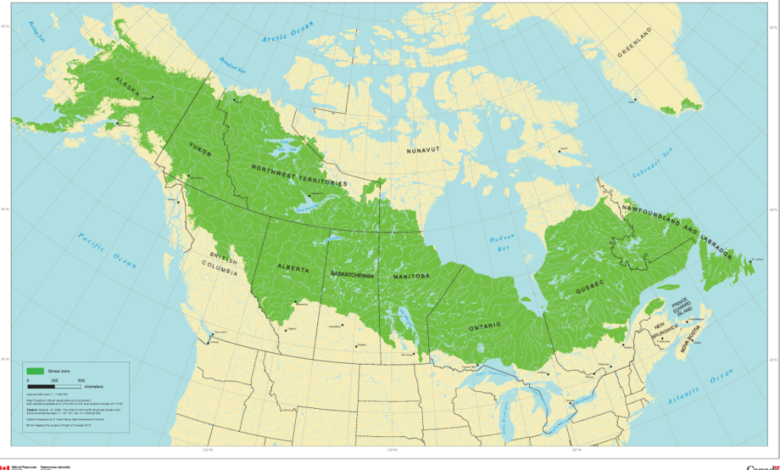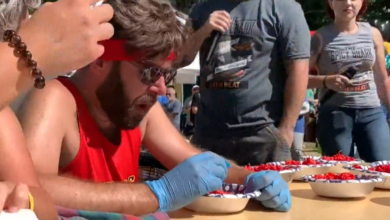Is paper towel made from Canada’s forests?

A new report suggests some of the most popular brands in Canada make paper towels with wood cut from key Canadian forests.
The report from the Natural Resources Defense Council (NRDC), a U.S. environmental non-profit organization, shows several big-name paper towel, toilet paper and facial tissue manufacturers are using trees from the boreal forest.
According to Natural Resources Canada, harvesting in Canada’s boreal forests is done “sustainably.”
These trees cut down through techniques that “emulate” natural disturbances, such as wildfires, the NRC told CTVNews.ca last year, in response to a previous NRDC report. CTVNews.ca reached out for comment on this year’s report, but did not hear back by deadline.
One of those practices used is clear-cutting, the NRC said.
NRDC alleges “hundreds of thousands of tonnes” of the wood pulp used in paper towel come from Canada’s boreal forest, which makes up 28 per cent of the world’s boreal zone, according to Natural Resources Canada (NRC).
The Canadian boreal forest covers 270 million hectares, in which spruce, fir, pine and tamarack trees are most common.
In its report published earlier this fall, the NRDC alleged the harvesting practices used by some companies are harming Canada’s “intact” forests. Its report said the forests impacted are key to the country’s ecosystems, as they promote biodiversity, absorb, capture and store carbon, and help mitigate the impacts of climate change.
 As the map shows, Canada’s boreal zone stretches from Yukon and northern British Columbia to Newfoundland & Labrador. (Natural Resources Canada.)“What is especially egregious is that these products are the epitome of waste products, like paper towels, which most people will use once and throw away,” Jennifer Skene, NRDC solutions policy manager for the Canada program, told CTVNews.ca in an interview. “We’re wiping our counters, we’re cleaning our houses and blowing our noses with one of the most globally important forests in the world, the Canadian boreal.”
As the map shows, Canada’s boreal zone stretches from Yukon and northern British Columbia to Newfoundland & Labrador. (Natural Resources Canada.)“What is especially egregious is that these products are the epitome of waste products, like paper towels, which most people will use once and throw away,” Jennifer Skene, NRDC solutions policy manager for the Canada program, told CTVNews.ca in an interview. “We’re wiping our counters, we’re cleaning our houses and blowing our noses with one of the most globally important forests in the world, the Canadian boreal.”
CTVNews.ca reached out to all the companies named in the report that sold paper towel brands available in Canada, to ask about sustainable practices and adapting to the environmental needs of Canadians.
Only one company provided comment in time for publication.
PAPER PRODUCT USE IN CANADA
Canadians used about 746,305 tonnes of household and sanitary paper in 2021, according to calculations by Peri Dworatzek, senior data analyst at Ecological Footprint Initiative at York University.
“For the national accounts, we take millions of data points from various international databases,” Dworatzek told CTVNews.ca in an interview.
“One of the major data sources we use is the Food and Agriculture Organization of the United Nations (FAOSTAT). This is where we source a lot of trade data, including data on household and sanitary papers.”
HOW THE BRANDS WERE RANKED
The NRDC report looked at paper towel brands on the market in June and determined a sustainability score using data from company websites, product packaging and news releases.
The NRDC gave the highest points to brands with paper towels made from 100 per cent recycled content, which it said has “enormous benefits” for the environment.
Manufacturers use pulp to make it, which is often a by-product of the logging industry.
Bamboo-based paper towels were also highly ranked due to being a “sustainable alternative” to wood, said NRDC.
But the majority of brands available to Canadians use wood from Canada’s old-growth forests, including the boreal forest, the report shows.
WHICH BRANDS RANKED WORST?
The highest-ranking sustainable paper towel available in Canada in the report is made by a U.S.-based company called Reel.
The company has a “premium recycled” product that has a Forest Stewardship Council (FSC) certification, the report said.
An FSC certification, according to NRDC, is the only system that minimizes logging impacts and safeguards Indigenous rights.
Those behind the report gave Reel’s product the letter grade A+.
Also at the top of the list was the American brand Seventh Generation, which is manufactured by Unilever, the company that owns Dove, Hellmann’s and Axe.
 The unbleached version of the paper towel by Seventh Generation ranked higher (A+) than its bleached version (A) due to the chemicals used to make the towels white.
The unbleached version of the paper towel by Seventh Generation ranked higher (A+) than its bleached version (A) due to the chemicals used to make the towels white.
Caboo sells an “earth-friendly” bamboo paper towel, which is available on sites like Amazon and Well.ca for Canadians. But it ranked lower (B) due to bleaching and for not avoiding old-growth bamboo forests, according to the NRDC.
The company addressed the scoring in an interview with CTVNews.ca, saying, “The bamboo is sourced from the Sichuan province of China where bamboo is native to the land and grows abundantly.”
A spokesperson from Caboo said, “Our team visits the area on a regular basis and in fact just came back from a visit to the region where the bamboo is sourced and the production facility.”
The brands Cheeky Panda and NatureZway ranked the same as Caboo for bamboo-based paper towels, for similar reasons.
Walmart’s Great Value paper towel ranked much lower in terms of sustainability, graded a D by those behind the report.
According to the NRDC report, 70 per cent of the product comes from wood harvested from forests, while the remaining 30 per cent is from recycled paper from various sources.
Along with being bleached and not avoiding old-growth forests, it is less sustainable, the report said.
Viva, a brand by Kimberly-Clark, ranked even lower on sustainability due to being 100 per cent forest fibre, according to the NRDC, which gave it a failing grade of F. The company does not have a full FSC certification protecting the environment, which means not all the environmental concerns are addressed. The paper is bleached with chemicals before it is shipped to stores, the organization says.
Georgia-Pacific’s brand Sparkle is 99 per cent forest fibre, but doesn’t have an FSC certification and bleaches the paper, the report said. For these reasons, NRDC gave the brand a grade of F.
Ranking the lowest on the NRDC’s list were brands Great Value Ultra Strong, by Walmart, and Kirkland, by Costco, with no points for sustainability.
Walmart’s brand is 100 per cent made from harvested trees, instead of recycled paper, and has no protections to the environment through certifications and bleaches the product, the report reads.
Costco’s product reportedly had the same issues as Walmart’s, with NRDC giving both products an F.
‘GALLING AND NONSENSICAL’
The NRDC’s Skene said most people don’t make the connection between paper towel and the “vibrant, thriving ecosystem” the material comes from.
“It’s galling and nonsensical,” Skene said. “There is no reason we need to be turning our forests — especially at a moment when we’re on the precipice of climate and biodiversity catastrophe — into products that are as short-lived and wasteful as paper towels and toilet paper.”
This year was the fifth edition of the report from NRDC.
Skene said she has seen improvements in brand awareness and sustainability of products over the years of compiling the report.
“It is very heartening to see that more brands than ever are embracing sustainable tissue products,” she said. “Recycled content or sustainably sourced bamboo has been continuously growing at a pretty fast clip, which has been very exciting to see.”
The NRDC says the goal of its scoresheet is to help consumers understand where the products come from and know which are sustainable. The results, Skene said, are people “appalled” to know the truth.
Canada’s boreal forest stores carbon in the ground from the atmosphere, helping to cool the Earth.
It is also “inextricably” tied to many Indigenous communities across Canada, Skene said.
“Whether you’re talking about species, or the climate, or human rights, and equity and justice, these are all bound up in those little rolls of toilet paper or paper towels that you find on your store shelves.”




